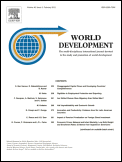A new working paper by Nathan Nunn and Nancy Qian:
This paper examines the effect of US food aid on conflict in recipient countries. To establish a causal relationship, we exploit time variation in food aid caused by fluctuations in US wheat production together with cross-sectional variation in a country’s tendency to receive any food aid from the United States. Our estimates show that an increase in US food aid increases the incidence, onset and duration of civil conflicts in recipient countries. Our results suggest that the effects are larger for smaller scale civil conflicts. No effect is found on interstate warfare.
This is bound to make waves among food policy scholars and in Washington, DC, where the Farm Bill, part of which sets guidelines for the provision of food aid, is due to be renewed this year.
I have not yet had a chance to read the paper (I’m teaching two classes this semester, so most of my reading time goes to those; I’ve been on the same “pleasure”-reading book since before Christmas), so please take the following with a grain of salt since it’s off the top of my head, but I wonder whether it might have made for cleaner identification to use weather shocks (specifically, extreme weather events and natural disasters) as a source of exogenous variation instead of fluctuations in US wheat production.
In other words, it could perhaps be the case that US wheat production affects conflict through means other than US food aid, so using unpredictable shocks to the supply of US food aid might make for more solid identification. But as I said, I have not yet had a chance to read the paper, and Nunn and Qian are both careful empiricists, so they probably address my concern somewhere in the paper.
UPDATE: Jon Prettyman, a Masters of Public Policy student advisee of mine, just emailed with this: “I saw the Nunn and Qian paper on several blogs today and I’m reading through it now, primarily because it sounds an awful lot like my thesis, and came across the answer to the question from your post. They did use weather in an earlier draft of the paper, but found that wheat production yields similar estimates and is easier to interpret.”

Our Risk Perceptions Do Not Make Much Sense
So much of what we think and do about risk does not make sense. (…) In Europe, where there are more cell phones than people and sales keep climbing, a survey found that more than 50 percent of Europeans believe the dubious claims that cell phones are a serious threat to health. And then there’s the striking contrast between Europeans’ smoking habits and their aversion to foods containing genetically modified organisms. Surely one of the great riddles to be answered by science is how the same person who doesn’t think twice about lighting a Gauloise will march in the streets demanding a ban on products that have never been proven to have caused so much as a single case of indigestion.
That’s Dan Gardner, in the introduction to his 2009 book Risk: The Science and Politics of Fear. Gardner also has another book out titled Future Babble, on the lack of accountability — not to mention the lack of accuracy — of experts making predictions.
I have the students in my Law, Economics, and Organization seminar read the beginning chapters of Gardner’s book as part of our in-class discussion of risk sharing and incentives, and they usually find Gardner’s book to be thought-provoking.